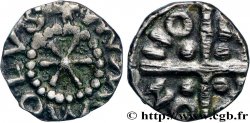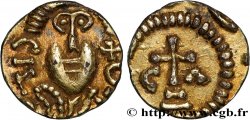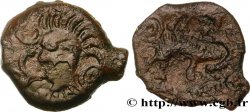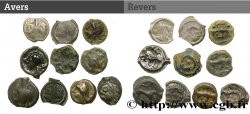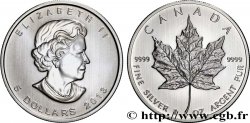v25_0806 - CHALON-SUR-SAÔNE (CABILONNUM) - Saône-et-Loire Denier à la croix
MONNAIES 25 (2006)
Starting price : 450.00 €
Estimate : 900.00 €
Realised price : 595.00 €
Number of bids : 2
Maximum bid : 910.00 €
Starting price : 450.00 €
Estimate : 900.00 €
Realised price : 595.00 €
Number of bids : 2
Maximum bid : 910.00 €
Type : Denier à la croix
Date: n.d.
Mint name / Town : 71 - Chalon-sur-Saône
Metal : silver
Diameter : 11 mm
Orientation dies : 12 h.
Weight : 1,20 g.
Rarity : UNIQUE
Coments on the condition:
Ce denier est frappé sur un flan oblong et irrégulier laissant une partie des légendes hors flan. Les reliefs sont nets sur les deux faces. Une patine foncée recouvre les champs de cet exemplaire
Catalogue references :
Obverse
Obverse description : Crois à six branches dans un grènetis ; légende autour.
Reverse
Reverse legend : CA - (...) - (...) - IXI.
Reverse description : Croix cantonnée d’un globule dans chaque canton ; légende en quatre parties.
Commentary
Denier du type de Chalon-sur-Saône, mais avec une légende de revers partielle et à la terminaison IXI inédite.
Tous ces deniers dérivent du bronze TEVDEBERTE / CA-BI-LON-NV (cf. Ponton d'Amécourt, pl. VI, n° 132) attribué à Théodebert Ier. La croix à six branches est considérée par certains comme étant un chrisme. Les deniers de Chalons sont classés selon le nom inscrit au droit ; BADOINVS, MVMMOLVS, MAROL, BIL...INVS, ABBO, NERTVNVS, INPORTVNVS ou BOBO. Mis à part cette inscription du droit, l'évolution de l'épigraphie CABILONNO, au revers, permet de proposer une datation relative. La chronologie proposée par Ponton d'Amécourt est la suivante ; CA BI LON NV, CA BIL ON NO, CA BL ON NO, puis enfin CA BLO NN O+. A l'aide de ces exemples, notre légende peut être restituée CA BIL ON IXI ou I+I. Certains exemplaires ont une croisette en début de légende (n° 133) ou en fin de légende (n° 136 -138). Dans cette hypothèse, nous aurions alors la légende CABILONI + I. Toutes les légendes répertoriées, tant sur le monnayage d'or que d'argent, ont pourtant NO comme terminaison.
Denier of the Chalon-sur-Saône type, but with a partial reverse legend and the unpublished ending IXI. All these deniers derive from the bronze TEVDEBERTE / CA-BI-LON-NV (cf. Ponton d'Amécourt, pl. VI, n° 132) attributed to Théodebert I. The six-branched cross is considered by some to be a chrism. The deniers of Chalons are classified according to the name inscribed on the obverse; BADOINVS, MVMMOLVS, MAROL, BIL...INVS, ABBO, NERTVNVS, INPORTVNVS or BOBO. Apart from this obverse inscription, the evolution of the epigraphy CABILONNO, on the reverse, allows us to propose a relative dating. The chronology proposed by Ponton d'Amécourt is as follows: CA BI LON NV, CA BIL ON NO, CA BL ON NO, then finally CA BLO NN O+. Using these examples, our legend can be restored as CA BIL ON IXI or I+I. Some examples have a cross at the beginning of the legend (no. 133) or at the end of the legend (no. 136-138). In this hypothesis, we would then have the legend CABILONI + I. All the legends listed, both on gold and silver coinage, have NO as the ending.
Tous ces deniers dérivent du bronze TEVDEBERTE / CA-BI-LON-NV (cf. Ponton d'Amécourt, pl. VI, n° 132) attribué à Théodebert Ier. La croix à six branches est considérée par certains comme étant un chrisme. Les deniers de Chalons sont classés selon le nom inscrit au droit ; BADOINVS, MVMMOLVS, MAROL, BIL...INVS, ABBO, NERTVNVS, INPORTVNVS ou BOBO. Mis à part cette inscription du droit, l'évolution de l'épigraphie CABILONNO, au revers, permet de proposer une datation relative. La chronologie proposée par Ponton d'Amécourt est la suivante ; CA BI LON NV, CA BIL ON NO, CA BL ON NO, puis enfin CA BLO NN O+. A l'aide de ces exemples, notre légende peut être restituée CA BIL ON IXI ou I+I. Certains exemplaires ont une croisette en début de légende (n° 133) ou en fin de légende (n° 136 -138). Dans cette hypothèse, nous aurions alors la légende CABILONI + I. Toutes les légendes répertoriées, tant sur le monnayage d'or que d'argent, ont pourtant NO comme terminaison.
Denier of the Chalon-sur-Saône type, but with a partial reverse legend and the unpublished ending IXI. All these deniers derive from the bronze TEVDEBERTE / CA-BI-LON-NV (cf. Ponton d'Amécourt, pl. VI, n° 132) attributed to Théodebert I. The six-branched cross is considered by some to be a chrism. The deniers of Chalons are classified according to the name inscribed on the obverse; BADOINVS, MVMMOLVS, MAROL, BIL...INVS, ABBO, NERTVNVS, INPORTVNVS or BOBO. Apart from this obverse inscription, the evolution of the epigraphy CABILONNO, on the reverse, allows us to propose a relative dating. The chronology proposed by Ponton d'Amécourt is as follows: CA BI LON NV, CA BIL ON NO, CA BL ON NO, then finally CA BLO NN O+. Using these examples, our legend can be restored as CA BIL ON IXI or I+I. Some examples have a cross at the beginning of the legend (no. 133) or at the end of the legend (no. 136-138). In this hypothesis, we would then have the legend CABILONI + I. All the legends listed, both on gold and silver coinage, have NO as the ending.







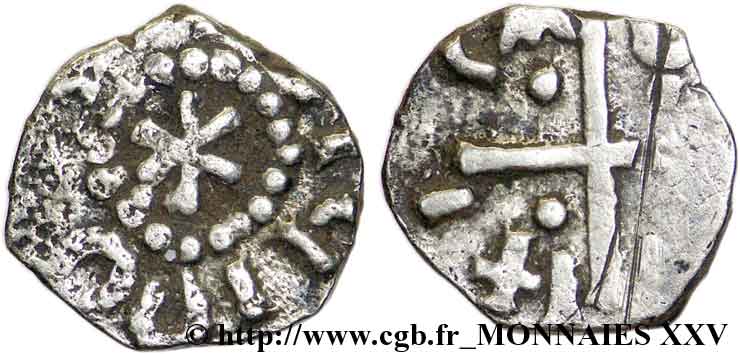
 Report a mistake
Report a mistake Print the page
Print the page Share my selection
Share my selection Ask a question
Ask a question Consign / sell
Consign / sell
 Full data
Full data

